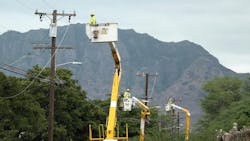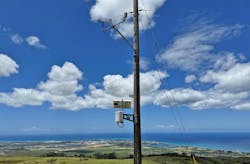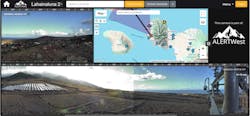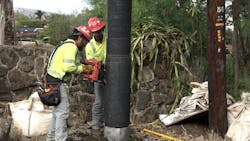Listen to the Audio Story in the Line Life Podcast ICYMI Series
As seen during the blaze that devastated Lahaina in August 2023, wildfires are a significant and persistent threat in Hawai‘i. Hawaiian Electric is meeting this challenge by accelerating the implementation of its Wildfire Safety Strategy that was created in 2019 and updated in the months after the windstorm and fires on Maui.
The latest update, an expanded three-year blueprint filed in January 2025 with the Hawai‘i Public Utilities Commission (PUC), highlights actions that will significantly reduce the risk of wildfire started by its equipment and increase situational awareness:
- Deploy covered conductor in the highest risk areas.
- Move overhead circuits underground in select areas of high risk.
- Replace, upgrade and strengthen poles and equipment.
- Install more AI-assisted high-definition video cameras to have visibility of all high and medium wildfire risk areas. Add more weather stations beyond the 53 installed in 2024 in wildfire-prone areas on four islands.
Four Pillars
As detailed in its 2025-2027 Wildfire Safety Strategy, Hawaiian Electric plans to deploy new technology, fortify infrastructure, minimize fire hazards and expand community partnerships. The enhanced plan, which was filed for review by the PUC, underscores the recent emergence of extreme weather events as requiring a coordinated effort by many organizations and supportive public policy to keep communities safe.
“Our 2025-2027 expanded Wildfire Safety Strategy builds upon our past work and that of many others,” said Shelee Kimura, president and CEO of Hawaiian Electric. “It is not just a technical road map, it is our shared and steadfast commitment to a safer, more resilient Hawai‘i. Hundreds of stakeholders and partners have contributed to wildfire prevention efforts, including the work that resulted in this plan. Through collective action and thoughtful approaches, Hawai‘i can create a fire-safe environment for generations to come.”
Hawaiian Electric’s enhanced Wildfire Safety Strategy is founded on a four-pillar approach to long-term reduction in wildfire risk. Each pillar reinforces the others and creates a comprehensive framework of actions that enhance resilience and fortify the electrical grid and communities against ignition. The four pillars are as follows:
Harden and redesign the grid — Upgrade infrastructure, such as installation of covered conductors, targeted undergrounding and equipment replacements to enhance fire safety. These efforts also aim to improve reliability impacts resulting from safer operational practices put in place in 2024.
Expand and improve situational awareness — Deploy weather stations, AI-assisted cameras and spotters to improve real-time fire weather monitoring and early identification of potential ignitions. Also implement a watch office and an operational wildfire risk model to inform real-time decision-making.
Improve operational practices — Use enhanced fast trip settings and public safety power shutoffs with advanced weather monitoring to reduce ignition risks. Also enact restoration procedures in areas with elevated wildfire risk. In addition, expand vegetation management programs and annual inspection of electrical assets in the highest-risk areas.
Strengthen stakeholder and community partnerships — Engage partners and the public through tailored outreach and collaborative events like the Wildfire Safety Symposium and Working Group meetings.
The cost of the 2025-2027 plan is estimated at about $450 million, including $137 million budgeted for work in 2025. Some of the cost is already funded through existing programs, including a federal grant for grid resilience received in 2024. The utility plans to continue refinement of the program, so the long-term cost and scope of work are subject to change.
Key 2024 Initiatives
The 179-page strategy was filed with the PUC on Jan. 10, 2025, for review and acceptance. Many of the initiatives described are already underway or recently completed.
In 2024, Hawaiian Electric undertook significant initiatives to enhance the resilience and safety of its infrastructure. The utility replaced and upgraded 2124 wood poles while also testing 5805 poles to ensure reliability. Additionally, more than 23 miles of older overhead lines were replaced with new, more resilient lines to improve the durability of the system.
To bolster safety measures, Hawaiian Electric installed 3177 single-phase fault current indicators in high-risk areas. These devices allow crews to more quickly locate and address disturbances on power lines. Furthermore, the utility replaced 3558 expulsion fuses to help reduce the risk of ignition and updated 213 substation relay settings to enable rapid power shutoff when disruptions are detected.
Addressing wildfire risks, the utility installed 53 weather stations in wildfire-prone areas on four islands. Mounted on utility poles, these stations provide critical data on wind, temperature and humidity, helping Hawaiian Electric better predict and respond to fire weather conditions. For example, the data can enable the utility to make informed decisions about activating and deactivating a public safety power shutoff. Additionally, the utility installed 44 AI-assisted high-definition wildfire detection cameras to monitor numerous wildfire risk areas.
The Next Three Years
Among the initiatives spanning the four pillars set to be completed in the next three years, Hawaiian Electric plans to continue grid hardening, asset inspections and vegetation management, prioritizing areas with medium to high risk of ignition. Covered conductors will be deployed in the highest-risk areas, and approximately 2 miles of overhead power lines will be undergrounded in critical safety areas in Lahaina. A community working group will be convened to provide area-specific knowledge and input on this effort.
The utility will replace, upgrade and strengthen poles and other equipment while also improving inspections of electrical assets. Vegetation management will be expanded through hazard tree removal and the creation of wider rights-of-way for vegetation clearing.
In addition, Hawaiian Electric will install even more weather stations and hazard-detection cameras, with the goal of enabling 100% camera viewshed coverage of all high and medium wildfire risk areas. To strengthen wildlife preparedness, the utility intends to create a watch office with meteorological expertise to provide more situational awareness within Hawaiian Electric. It will also implement an operational wildfire risk model to support real-time decision-making and refine its public safety power shutoff program.
Engaging with stakeholders and communities will remain a priority. Hawaiian Electric will continue convening Wildfire Safety Working Group meetings to bring experts together and share best practices. Additionally, the utility will continue partnering with local organizations to host community events, reach individual residents and share resources.
Significant Risk Reduction
With the enhancements implemented in 2024 and those planned through the 2025-2027 Wildfire Safety Strategy, Hawaiian Electric’s initial risk modeling estimates that, by the end of 2027, the baseline risk of electrical facilities igniting a significant wildfire will be diminished by an estimated 68% to 72%. While this marks substantial progress in risk reduction, the responsibility does not rest with the utility alone.
Preventing devastating wildfires requires a collective effort across the state to address risks that extend beyond utility infrastructure. Collaboration among all stakeholders is essential to fortify public safety and support the long-term economic resilience of communities.
About the Author
Marc Asano
Marc Asano is the Director of Integrated Grid Planning with over 17 years of utility experience. He has led Hawaiian Electric’s development of long-range plans and strategies to achieve 100% renewable energy, including significant quantities of distributed energy resources, its grid modernization strategy and most recently its Wildfire Safety Strategy.





